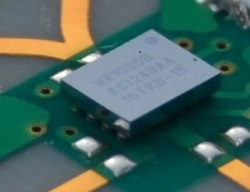Can digitally tunable capacitors revolutionize wireless communications?
Thinking about the numerous forms of wireless communication we employ today can make your head spin. We have 2G, 3G, and 4G cellular networks, Bluetooth and Zigbee WPANs, GPS and GLONASS mobile satellite, Wireless USB, Wi-Fi, standard radio bands, RFID, and LTE. Different wireless standards deployed on different frequency bands supplied by different regional carriers. Yikes!
To add another level of complexity to the mix, most of the mobile devices we commonly use such as smart phones and tablets are multiband. They support multiple frequency bands to access the different wireless networks so that they can perform required functions or execute specific applications.

DuNE digitally tunable capacitor from Peregrine.
Keeping all these signals tuned in and users happy is a daunting task. To make it work, optimizing antenna performance and improving the narrow bandwidth of RF front ends is essential. However, this is becoming increasingly difficult as mobile devices become thinner and at the same time, more functionally complex. Engineers are pressed to come up with more creative ways to efficiently use design space and battery power while maintaining quality signal strength.
With this aspect in mind, one RF technology that is gaining momentum and has the potential to be a true game changer are digitally tunable capacitors (DTCs.) These components are single-chip devices containing a core capacitor array and RF circuitry whose interconnections can be instantaneously switched and reconfigured through digital control. This enables dynamic tuning of the antenna through active-impedance matching, which adjusts for the frequency of operation and compensates for environmental effects.

The WS1035 tunable capacitor from WiSpry.
The ability of a DTC to keep the antenna optimally tuned keeps signals at a nominally higher level with better quality over a wider frequency range. This boosts the useful operational range of the mobile device. It also saves on battery use by reducing the amount of power normally needed to boost weak signals. This is a common energy drain on fixed narrow band tuning systems that often are not perfectly tuned. Additionally, using DTCs can reduce the total number of components required for RF front ends. This saves on space and further reduces battery usage.
Leading manufacturers of DTCs, such as Peregrine Semiconductor and WiSpry, are using innovative design techniques which are putting these devices into play in portable electronics. WiSpry uses a MEMS-based architecture to implement micro-level switching between capacitive elements. Peregrine Semiconductor switches between fixed, High-Q MIM capacitors using CMOS FETs. Both techniques enable the required RF circuitry to be implemented on a single, low power, chip scale device suitable for mobile products.
As this technology continues to develop and gain ground we may witness a significant transformation in wireless communication. DTCs may form a key building block for true global multiband devices.
For more information on DTC technology, visit the websites for Peregrine Semiconductor (www.psemi.com/) and WiSpry (www.wispry.com/).
Advertisement
Learn more about Electronic Products Magazine





